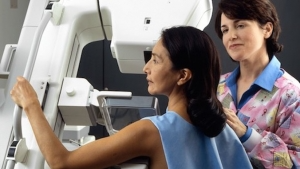AI Can Predict Cancer Risk Through Mammograms
As a hereditary disease, breast cancer has affected hundreds of families throughout the state. Annually, an average of 1,190 women are diagnosed with breast cancer in Hawaiʻi.
 John Shepherd As October approaches in recognition of National Breast Cancer Awareness Month, new public impact research from the University of Hawaiʻi Cancer Center is using artificial intelligence (AI) to improve risk assessment for breast cancer to aid in prevention and early detection, improving breast cancer outcomes for women all over the world.
John Shepherd As October approaches in recognition of National Breast Cancer Awareness Month, new public impact research from the University of Hawaiʻi Cancer Center is using artificial intelligence (AI) to improve risk assessment for breast cancer to aid in prevention and early detection, improving breast cancer outcomes for women all over the world.
 A technician assists a patient at an imaging machine to receive a mammogram. Photo credit: National Cancer Institute
A technician assists a patient at an imaging machine to receive a mammogram. Photo credit: National Cancer Institute
To reduce unnecessary imaging for breast cancer and costs associated with it, UH Cancer Center Researcher John Shepherd and his colleagues found that AI is able to distinguish between the mammograms of women who are more likely to develop breast cancer later on, and those who are not. The study was published in Radiology.
“Conventional methods of breast cancer risk assessment using clinical risk factors haven’t been that effective,” said Shepherd, study lead author and a professor in the Population Sciences in the Pacific Program (epidemiology). “We thought that there was more in the image than just breast density that would be useful for assessing risk.”
Deep learning model
Compared to commonly used clinical risk factors, a sophisticated type of AI called deep learning has been found to be better at using mammograms to differentiate between women who will and will not be diagnosed with breast cancer in the future. Typically, mammograms provide a measure of breast cancer risk through measurements of breast density. While denser breasts on mammography are associated with a higher risk of cancer, there are other factors hidden in mammograms that are likely to contribute risk.
 Two normal mammograms showing the difference between a dense breast (left) and a fatty breast (right). Photo credit: National Cancer Institute
Two normal mammograms showing the difference between a dense breast (left) and a fatty breast (right). Photo credit: National Cancer Institute
The study used a data set of more than 25,000 digital screening mammograms from 6,369 women who participated in screening mammography from 2006 to 2014. The researchers trained the deep learning model to find details and signals in the mammogram that might be linked to increased cancer risk. When they tested the deep learning-based model, it underperformed in assessing the risk factors for interval cancer risk (cancers diagnosed between routine screenings), but outperformed clinical risk factors in determining screening-detected cancer risk.
“The results showed that the extra signal we’re getting with AI provides a better risk estimate for screening-detected cancer than other forms of assessment,” said Shepherd. “It helped us accomplish our goal of classifying women into low risk or high risk of screening-detected breast cancer.”
He added, “By ranking mammograms in terms of the probability of seeing cancer in the image, AI is going to be a powerful second reading tool to help categorize mammograms.”
Researchers are planning to replicate the study in Native Hawaiian and Pacific Islander women, two groups that have been underrepresented in breast cancer research. They also want to extend the work beyond cancer risk to look at the risk of different grades of breast cancer, from least to most aggressive.
Learn more about breast cancer causes, prevention, treatment and screening here.
This research is an example of UH Mānoa’s goal of Excellence in Research: Advancing the Research and Creative Work Enterprise (PDF), one of four goals identified in the 2015–25 Strategic Plan (PDF), updated in December 2020.
Publication: Xun Zhu, et al. Deep Learning Predicts Interval and Screening-detected Cancer from Screening Mammograms: A Case-Case-Control Study in 6369 Women. Radiology, (2023). DOI: 10.1148/radiol.2021203758
Original Story Source: University of Hawaii at Manoa

 Alerts Sign-up
Alerts Sign-up